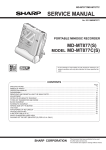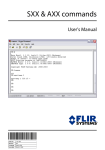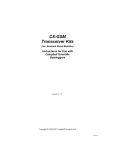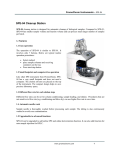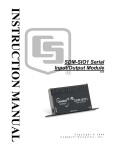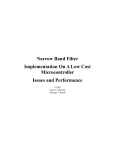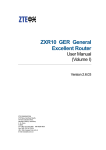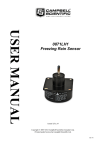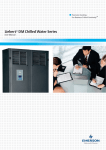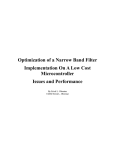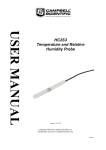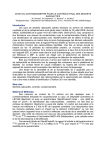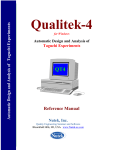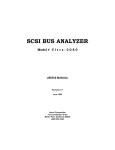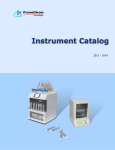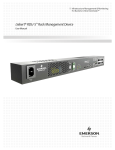Download AlphaGUARD Radon Monitor Application Note
Transcript
APPLICATION NOTE App. Note Code: 2MI-U Rev. 1 Interfacing the AlphaGUARD Radon Monitor with Campbell Scientific's CR1000 Datalogger Copyright (C) September 2009 Campbell Scientific, Inc. Interfacing the AlphaGUARD Radon Monitor with Campbell Scientific's CR1000 Datalogger This application note describes interfacing a CR1000 datalogger with a “standard version” of the AlphaGUARD Professional Radon Monitor Model P30 (not the “overdrive” version). The efforts to interface the AlphaGUARD Radon Monitor with the CR1000 Datalogger, and the writing of this application note were accomplished in collaboration with personnel from DRI, the environmental research arm of the Nevada System of Higher Education1. The AlphaGUARD is manufactured by Saphymo GmbH (www.saphymo.de)2. This document is intended as a supplement to the manufacturer’s brochure and the manuals titled: “User Manual Portable Radon Monitor “AlphaGUARD dated 12/98” and “AlphaGUARD Data Transfer – Specifications version 4.0 dated 7/97”. 1. Radon Detection Basics Two techniques are available for measuring radon activity; the best technique to use depends on the application. The techniques are integrative, passive radon sampling and continuous active radon sampling. Integrative, passive radon sampling does not require electrical power, whereas continuous active radon sampling does. Examples of sensors that can measure radon levels include alpha track detectors, activated charcoal adsorption devices, and the AlphaGUARD monitor. Alpha track detectors are integrative, passive radon sampling devices that do not require ac power. They contain a thin piece of plastic or film mounted in the detector. Radon flows into the detector through a filtered opening. As the radon inside the detector decays, the emitted alpha particles hit the film forming tracks on the film. The tracks are counted to determine radon concentration. These detectors are not very effective in measuring high concentrations of radon [Spe04]. Activated charcoal devices are passive sensors that do not require ac power. They consist of a canister that holds granular-activated carbon (i.e., activated charcoal). The charcoal absorbs radon that enters the canister via a screened opening. After a determined exposure period, the canister is sealed and the charcoal is analyzed using a HPGe gamma ray detector [Ger04]. Activated charcoal devices are preferable for short-term measurements (i.e., 1 to 7 days). They are not practical for locations with high humidity because the charcoal can become saturated [Ger04]. The AlphaGUARD radon monitor is a continuous active radon sampling sensor. It has an ionization chamber and uses an alpha spectroscopy to detect radon. The two common isotopes of radon (i.e., 222Rn and 220Rn) are identified through their respective energies from the alpha decays [Swa04]. The signal generated from the alpha detection is converted to a digital output. This output can be read by the AlphaGUARD, dataloggers, or a PC. Ideal applications for the AlphaGUARD include radon exhalation, radon soil-gas, indoor, outdoor, in mining environments and in-water storage radon measurements. 1DRI Project: Ambient Radon Monitoring in Amargosa Valley, Nevada DRI Personnel: Greg McMurdy ([email protected]), Jeff Tappen ([email protected]) 2AlphaGUARD Professional Radon Monitor Model P30 is manufactured by Saphymo GmbH, Heerstraße 149, D-60488, Frankfort Germany, www.saphymo.de. In the U.S., the AlphaGUARD is available from Rad Elec, Inc., 5716-A Industry Lane, Frederick, Maryland 21704, www.radelec.com; phone (800) 526-5482, (301) 694-0011; fax (301) 694-0013. Approximate price is 6575 EUR or US $9,886. Copyright © 2009 Campbell Scientific, Inc. 815 W. 1800 N., Logan, UT 84321-1784 (435) 753-2342 1 App. Note: 2MI-U Interfacing the AlphaGUARD with the CR1000 2. AlphaGUARD Sensor Description The AlphaGUARD is designed for long-term monitoring of radon gas concentration. It has a linear response from 2 to 2,000,000Bq/m3 (0.05 to 50,000 pCi/l). See the next section and the AlphaGUARD brochure for more specifications. The AlphaGUARD measures radon concentration using 3D alpha spectroscopy. There is a lag in the signal due to the time required for radon to diffuse into the ionization chamber. When exposed to a step change in radon concentration, the AlphaGUARD will reach 30% of the new value after 10 minutes, 70% after 20 minutes and 90% after 30 minutes. The AlphaGUARD has an internal battery that will run it for approximately 10 days. The unit can be AC powered with an AC to 12 Vdc wall charger from Radio Shack or CSI pn15966. Alternatively the AlphaGUARD may be DC powered using CSI pn14291. CSI pn14291 has a mating barrel connector on one end and red and black stripped and tinned leads to be connected to 12 Vdc and ground on the other end. Figure 1. Front view of the AlphaGUARD Professional Radon Monitor Model P30 (standard version). 3. Specifications The best source of specifications on the AlphaGUARD is the manufacturer’s brochure which may be found at www.genitron.de/download/ag_fb_gb_01_a4.pdf. A few specifications are listed below for your convenience. Campbell Scientific recommends you refer to the manufacturer's brochure to verify critical specifications. 2 App. Note: 2MI-U Measurement Range: 2 to 2,000,000 Bq/m3 (0.05 to 50,000 pC/liter) Operating temperature: +14° to +122°F (-10° to +50°C) Operating pressure: 700 to 1100 mbar Operating RH: 0 to 99% RH Operating voltage: 12 Vdc (or 110 Vac with converter to 12 Vdc) Current drain: unknown (unit will run on internal battery for 10 days) Copyright © 2009 Campbell Scientific, Inc. 815 W. 1800 N., Logan, UT 84321-1784 (435) 753-2342 Interfacing the AlphaGUARD with the CR1000 4. Installation The AlphaGUARD must be switched on manually (On/Off switch). Using the “Menu”, “Change”, and “Accept” buttons and the display, set the AlphaGUARD measuring cycle to 10 minutes and the baud rate to 9600 baud. The datalogger will time stamp the data but if it is important that the display indicate the correct time, set the AlphaGUARD clock using the serial interface software “DataEXPERT” provided with the unit. The AlphaGUARD user manual indicates the automatic background correction of the AlphaGUARD can only be executed at the beginning of a measuring series. Therefore with measurements lasting longer than six months, the set up of a new measuring series should be manually enforced, by turning the power switch OFF and then on again after every half year. Setting the system clock with DataEXPERT will also initiate a new measuring series. 5. Wiring The following wiring diagram is built for the program in Section 6 which is where the CR1000’s COM1 port (C1 & C2) will request and capture data from AlphaGUARD’s RS-232 port. The color scheme indicated in the last column is specific to the two foot long “DTE” cable which is one of two cables that come in Campbell Scientific’s model SC110 (or pn16721). TABLE 1: AlphaGUARD to CR1000 Wiring AlphaGUARD Function AlphaGUARD 9-pin CR1000 Terminal CR1000 Function CSI SC110 DTE color TxD 2 C2 RxD White RxD 3 C1 TxD Brown GND 5 GND GND Yellow GND Shell GND Clear Figure 2. Above shows the AlphaGUARD connected to a CR1000 datalogger. Copyright © 2009 Campbell Scientific, Inc. 815 W. 1800 N., Logan, UT 84321-1784 (435) 753-2342 3 App. Note: 2MI-U Interfacing the AlphaGUARD with the CR1000 6. Example Program for the CR1000 This CR1000 program is for the “standard version” of the AlphaGUARD, not the “overdrive” version. It was tested on an AlphaGUARD with serial number 1635 EF. 'CR1000 Series Datalogger ' ' Program for Alphaguard Radon detector Public fpval Public sign Public mantissa Public exp1 Public exponent Public Radon,RadonErr,AirTemp,RelHum,BaroPress Public Akkustd,KBeqstd,Totalstd Public ASerial as string * 6,Aversion as string * 4 Public PTemp, batt_volt ' Public HexV(80) as String *2 ': for debugging DataTable (Test,1,-1) DataInterval (0,15,Sec,10) Minimum (1,batt_volt,FP2,0,False) Sample (1,PTemp,FP2) EndTable Public Str3 As String * 80 Public CurrDate as String * 12 Public DataDate as String * 12 Public Atemp, Arh Public start As Long,i, rtnbyte(2), array(129) As Long Alias array(8) = year Alias array(9) = month Alias array(10)=days Alias array(11)=hrs Alias array(12)=minutes Alias array(13)=seconds Alias array(14)=mesyear Alias array(15)=mesmonth Alias array(16)=mesday Alias array(17)=meshr Alias array(18)=mesmin Alias array(19)=messec Alias array(20)=notused Alias array(28)=cycletime Alias array(35)=DataQA Alias array(36)=sysQA 4 App. Note: 2MI-U Copyright © 2009 Campbell Scientific, Inc. 815 W. 1800 N., Logan, UT 84321-1784 (435) 753-2342 Interfacing the AlphaGUARD with the CR1000 Function FLP2 (mant,expo) sign = IIF(expo AND &H80,1.0,-1.0) mantissa = mant/256.0 exp1 = (expo AND &H7F) - 64 exponent = PWR(2,exp1) FLP2 = (sign * mantissa) * exponent EndFunction Function FLP4 (mant1,mant2,mant3,expo) sign = IIF(expo AND &H80,1.0,-1.0) mantissa = (mant3 + ((mant2*256)) + ((mant1*65536)))/16777216 exp1 = (expo AND &H7F) - 64 exponent = PWR(2,exp1) FLP4 = (sign * mantissa) * exponent EndFunction BeginProg 'Open COM1 at 9600 baud SerialOpen (Com1,9600,3,10,1000) ' format for binary, 8-bit, no parity. Scan (10,Sec,0,0) PanelTemp (PTemp,250) Battery (Batt_volt) If TimeIntoInterval (0,1,Min) start = 1 endif If start Then ' Output string to query Alphaguard SerialFlush(com1) ' Clean out buffers Str3 = CHR(2) SerialOutBlock (Com1,Str3,1) Delay (0,100,mSec) str3= CHR(3) + CHR(83) + CHR(3) + CHR(91) SerialOutBlock (Com1,Str3,4) ' Wait for return of data from Alphaguard Delay (0,4,Sec) i=1 rtnbyte(2)=SerialInChk(com1) While rtnbyte(2) i=i+1 SerialInBlock(Com1,array(1),1) MoveBytes (array(i),3,array(1),0,1) Copyright © 2009 Campbell Scientific, Inc. 815 W. 1800 N., Logan, UT 84321-1784 (435) 753-2342 5 App. Note: 2MI-U Interfacing the AlphaGUARD with the CR1000 ' following line useful for debugging ' hexV(i) = Hex(array(i)) rtnbyte(2)=SerialInChk(com1) Wend start=0 CurrDate = right("0" & Hex(year),2) & right("0" & Hex(month),2) & right("0" & Hex(days),2) CurrDate = CurrDate & right("0" & Hex(hrs),2) & right("0" & Hex(minutes),2) & right("0" & Hex(seconds),2) DataDate = right("0" & Hex(mesyear),2) & right("0" & Hex(mesmonth),2) & right("0" & Hex(mesday),2) DataDate = DataDate & right("0" & Hex(meshr),2) & right("0" & Hex(mesmin),2) & right("0" & Hex(messec),2) Radon = FLP2(array(32),array(31)) RadonErr = FLP2(array(34),array(33)) AirTemp = FLP2(array(40),array(39)) RelHum = FLP2(array(46),array(45)) BaroPress = FLP4(array(42),array(43),array(44),array(41)) Akkustd = FLP4(array(48),array(49),array(50),array(47)) KBeqstd = FLP4(array(52),array(53),array(54),array(51)) Totalstd = FLP4(array(56),array(57),array(58),array(55)) ASerial = CHR(array(60)) & CHR(array(61)) & CHR(array(62)) & CHR(array(63)) & CHR(array(64)) & CHR(array(65)) AVersion = CHR(array(66)) & CHR(array(67)) & CHR(array(68)) & CHR(array(69)) EndIf NextScan EndProg 7. Maintenance and Troubleshooting See AlphaGUARD User Manual. 8. References 6 App. Note: 2MI-U [Ger04] Gervino, G., Bonetti, R., Cigolini, C., Marino, C., Prati, P., Pruiti, L. (2004). Environmental radon monitoring: comparing drawbacks and performances of charcoal canisters, alpha-track and E-PERM detectors. Nuclear Instruments and Methods in Physics Research A, Vol. 518, pp 452 – 455. [Spe04] Speelman, W., (2004). Master of Science full thesis, Department of Physics, University of the Western Cape, Australia. Modeling and Measurement Of Radon Diffusion Through Soil for Application On Mine Tailings Dams, pp. 36 - 63. http://etd.uwc.ac.za/usrfiles/modules/etd/docs/etd_init_9490_1178282920.pdf [Swa04] Swakon, J., Kozak, K., Paszkowski, M., Gradzinski, R., Łoskiewicz, J., Mazur, J., Janik, M., Bogacz, J., Horwacik, T., Olko, P. (2004). Radon concentration in soil gas around local disjunctive tectonic zones in the Krakow area. Journal of Environmental Radioactivity, Vol. 78, Issue 2, pp 137 – 149. Copyright © 2009 Campbell Scientific, Inc. 815 W. 1800 N., Logan, UT 84321-1784 (435) 753-2342








